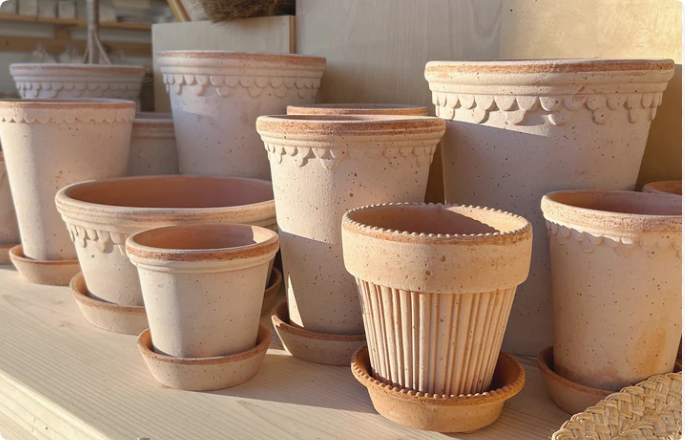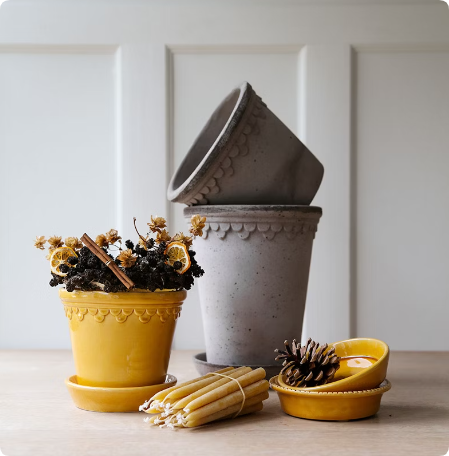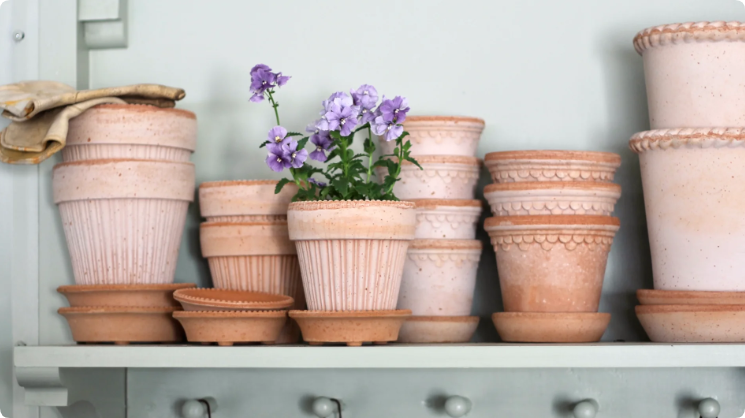In the world of gardening, choosing the right container for your plants can make all the difference in their growth and health. Among the many available options, ceramic pots stand out for their elegance, durability, and, most importantly, their benefits to plants. Whether you’re a seasoned gardener or just starting your green-thumb journey, understanding why ceramic pots are good for plants can help elevate your gardening game.
This comprehensive pillar post will delve into the advantages of ceramic pots for plants, comparing them to other materials like plastic and terracotta, and discussing how they enhance plant growth, aesthetic appeal, and overall gardening experience. Let’s explore the myriad reasons why ceramic pots are the ultimate choice for your indoor and outdoor plants.
Table of Contents:
- 1.Introduction to Ceramic Pots
- 2.Benefits of Ceramic Pots for Plant Growth
- Moisture Retention and Breathability
- Temperature Regulation
- Durability and Longevity
- 3.Aesthetic Appeal of Ceramic Pots
- Design Versatility
- Customization and Personalization
- 4.Ceramic Pots vs. Other Materials
- Ceramic vs. Plastic Pots
- Ceramic vs. Terracotta Pots
- 5.Ideal Plants for Ceramic Pots
- Succulents
- Herbs and Small Vegetables
- Flowering Plants
- 6.Caring for Plants in Ceramic Pots
- Watering and Drainage Considerations
- Potting Mix and Soil Types
- 7.Sustainable and Eco-friendly Benefits of Ceramic Pots
- Natural Materials and Environmentally Friendly Manufacturing
- Recyclability and Long-Term Use
- 8.Common Myths about Ceramic Pots
- 9.Where to Buy the Best Ceramic Pots
- 10.Conclusion
1.Introduction to Ceramic Pots
Ceramic pots have been used for centuries, dating back to ancient civilizations that utilized clay to create durable and aesthetically pleasing containers for plants and flowers. Today, they remain one of the most popular choices for plant lovers and gardeners due to their exceptional properties and stylish designs.
Ceramic pots are made from clay that is fired at high temperatures, creating a non-porous or semi-porous structure, depending on the finish. This process results in pots that are strong, durable, and often glazed to improve their water resistance and appearance. But beyond their beauty, what makes ceramic pots so good for plants?
In this guide, we will examine how ceramic pots contribute to plant health, explore their aesthetic and environmental benefits, and compare them to other types of plant containers.

2.Benefits of Ceramic Pots for Plant Growth
Moisture Retention and Breathability
One of the main reasons ceramic pots are highly recommended for plant growth is their ability to retain moisture while also allowing for breathability. The semi-porous nature of unglazed ceramic pots provides a perfect balance between water retention and air circulation.
Plants in ceramic pots are less prone to waterlogging compared to plastic containers, which lack the breathability necessary for healthy root systems. The slight porosity of ceramics enables excess moisture to evaporate naturally, preventing root rot and promoting healthier plant growth.
For gardeners in dry climates or those caring for moisture-sensitive plants like succulents and cacti, ceramic pots offer a moisture-regulating advantage that helps maintain a consistent watering routine.
Temperature Regulation
Ceramic pots are excellent insulators, making them ideal for protecting plant roots from extreme temperature fluctuations. This is particularly important for plants that are sensitive to changes in temperature, such as certain indoor plants or those grown in outdoor settings where weather conditions can vary drastically.
During hot summers, ceramic pots prevent the soil from overheating, shielding the plant roots from excessive heat. Similarly, in cooler months, the insulating properties of ceramics keep the roots warmer, allowing plants to survive in less-than-ideal outdoor conditions.
Durability and Longevity
Ceramic pots are known for their strength and durability. Unlike plastic pots, which can degrade over time due to exposure to sunlight and fluctuating temperatures, ceramic pots are built to last. High-quality ceramic pots can withstand outdoor conditions and resist cracking, fading, or warping.
This long-lasting nature makes them an excellent investment for both novice and experienced gardeners. With proper care, ceramic pots can be used season after season without losing their structural integrity, offering both aesthetic and practical benefits for your garden.
3.Aesthetic Appeal of Ceramic Pots
Design Versatility
Ceramic pots come in a wide variety of designs, colors, and finishes, making them a popular choice for those who value both form and function in their garden decor. Whether you prefer classic, rustic styles or modern, sleek designs, there’s a ceramic pot that will match your aesthetic.
From vibrant glazed surfaces to minimalist matte finishes, ceramic pots can complement any home or garden setting. Their design versatility extends to different shapes and sizes, allowing you to choose pots that not only fit your plants but also enhance the overall look of your indoor or outdoor space.
Customization and Personalization
One of the unique benefits of ceramic pots is the potential for customization. Many manufacturers and artisans offer hand-painted or handcrafted ceramic pots that can be tailored to your specific preferences. Whether you want a pot that features intricate designs, vibrant patterns, or personalized colors, ceramic pots offer endless possibilities for self-expression.
This customization makes ceramic pots perfect for adding a personal touch to your garden or home, making them a favorite choice for plant enthusiasts who enjoy creating visually appealing displays.

4.Ceramic Pots vs. Other Materials
When choosing the right container for your plants, it’s important to understand how ceramic pots compare to other popular materials like plastic and terracotta. Each has its own set of advantages and disadvantages, but ceramic pots often come out on top in terms of plant health and aesthetic appeal.
Ceramic vs. Plastic Pots
Plastic pots are widely used because they are inexpensive, lightweight, and available in a variety of shapes and sizes. However, they lack the breathability and insulation properties of ceramic pots. Plastic pots can trap moisture, leading to waterlogged soil and root rot, especially for plants that require well-draining conditions.
In contrast, ceramic pots offer better moisture control, thanks to their semi-porous nature. They also provide a more natural, earth-friendly option since plastic pots are often made from non-biodegradable materials that contribute to environmental pollution.
Ceramic vs. Terracotta Pots
Terracotta pots, like ceramic pots, are made from clay, but they differ in the firing process and finish. Terracotta is more porous than glazed ceramics, which means it allows water and air to pass through more easily. While this can be beneficial for some plants, it can also lead to soil drying out more quickly.
Ceramic pots, especially those with a glazed finish, strike a balance between breathability and moisture retention, making them suitable for a wider variety of plants. Additionally, ceramic pots offer more design options and are often considered more aesthetically pleasing than the plain, earthy appearance of terracotta.

5.Ideal Plants for Ceramic Pots
Ceramic pots are suitable for a wide range of plants, but certain species thrive particularly well in them. Here are some plant types that are ideal for ceramic pots:
Succulents
Succulents, including popular varieties like aloe vera, echeveria, and jade plants, are well-suited to ceramic pots due to their moisture-retaining properties. These drought-tolerant plants prefer soil that dries out between waterings, and ceramic pots help maintain the perfect balance by preventing excess moisture buildup.
Herbs and Small Vegetables
Herbs such as basil, thyme, and mint grow well in ceramic pots, especially when placed indoors where temperature and moisture levels can be more easily controlled. Small vegetable plants like cherry tomatoes or peppers can also thrive in ceramic containers, particularly in urban gardening settings where space is limited.
Flowering Plants
Flowering plants like orchids, African violets, and peace lilies benefit from the moisture retention and temperature regulation provided by ceramic pots. These plants often require consistent moisture without becoming waterlogged, and ceramic pots create an ideal environment for their growth.
6.Caring for Plants in Ceramic Pots
While ceramic pots offer many benefits for plant growth, there are some care considerations to keep in mind to ensure your plants stay healthy.
Watering and Drainage Considerations
Ceramic pots, particularly glazed ones, may not always have drainage holes. If your pot lacks proper drainage, it’s important to monitor the watering carefully to prevent water from accumulating at the bottom. Using a well-draining potting mix and adding a layer of stones or pebbles at the base can help improve drainage and avoid waterlogged roots.
Alternatively, you can look for ceramic pots specifically designed with drainage holes to make watering more convenient and ensure your plants receive the right amount of moisture.
Potting Mix and Soil Types
Choosing the right potting mix is essential when using ceramic pots. Depending on the plant, you may need a mix that retains moisture or one that drains more quickly. For succulents and cacti, a sandy, well-draining soil is recommended, while flowering plants may benefit from a nutrient-rich, loamy mix.
Regularly refreshing the soil and repotting plants as they grow ensures that your plants continue to receive the nutrients they need to thrive.
7.Sustainable and Eco-friendly Benefits of Ceramic Pots
In today’s environmentally conscious world, ceramic pots stand out as a sustainable option for eco-friendly gardeners. Here’s why:
Natural Materials and Environmentally Friendly Manufacturing
Ceramic pots are made from natural clay, a renewable resource that is abundant in many parts of the world. The production process for ceramic pots involves firing clay at high temperatures, which, while energy-intensive, results in a product that is long-lasting and biodegradable.
Unlike plastic pots, which contribute to landfill waste and are often made from non-renewable materials, ceramic pots are a more sustainable choice for environmentally minded gardeners.
Recyclability and Long-Term Use
Ceramic pots are highly durable and can last for many years, reducing the need for frequent replacements. If a ceramic pot does break, it can be recycled or repurposed in creative ways, such as using broken pieces for drainage in other pots or as decorative elements in the garden.
By investing in ceramic pots, you contribute to reducing the environmental impact of disposable plastic pots and embrace a more sustainable approach to gardening.
8.Common Myths about Ceramic Pots
There are several misconceptions about ceramic pots that can make gardeners hesitant to use them. Let’s debunk some of the most common myths:
- Myth 1: Ceramic Pots are Too Heavy
While it’s true that ceramic pots are heavier than plastic or terracotta pots, this weight adds to their stability. Heavier pots are less likely to tip over in windy conditions or if placed in high-traffic areas, making them ideal for outdoor use. - Myth 2: Ceramic Pots are Prone to Cracking
High-quality ceramic pots are highly durable and resistant to cracking. Issues with cracking usually arise from using low-quality or poorly manufactured ceramics. By choosing pots from reputable manufacturers, you can avoid this problem. - Myth 3: Ceramic Pots are Expensive
While some handcrafted or designer ceramic pots can be pricey, there are plenty of affordable options available. Ceramic pots offer long-term value due to their durability, making them a cost-effective investment for gardeners over time.
9.Where to Buy the Best Ceramic Pots
If you’re ready to invest in ceramic pots for your plants, there are numerous places to find high-quality, beautiful options. Here are some tips on where to shop:
- Local Garden Centers and Nurseries
Many local garden centers carry a wide selection of ceramic pots in various designs and sizes. Shopping locally allows you to see the pots in person and choose the right size for your plants. - Online Retailers
Websites like Amazon, Etsy, and specialized garden retailers offer a vast selection of ceramic pots. Online shopping provides convenience, but be sure to check customer reviews and product details to ensure you’re getting a durable, high-quality pot. - Artisan Pottery Studios
For unique, handcrafted ceramic pots, consider purchasing from local artisans or pottery studios. These one-of-a-kind pieces can add a personal touch to your garden while supporting local artists. - Small order custom factory
For example, we support one-stop procurement customization haleplanter.com
10.Conclusion

Ceramic pots are an excellent choice for anyone looking to enhance their plant care routine and elevate the aesthetic of their indoor or outdoor space. From their moisture-regulating properties to their ability to protect plants from extreme temperatures, ceramic pots offer a range of benefits that make them ideal for various plant types.
In addition to their practical advantages, ceramic pots also contribute to sustainability efforts by being made from natural materials and offering long-term durability. Whether you’re growing succulents, herbs, or flowering plants, ceramic pots provide a stylish and eco-friendly solution that supports healthy plant growth.
By understanding why ceramic pots are good for plants, you can make informed decisions about how to best care for your plants and create a thriving, beautiful garden.

